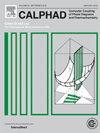calphad引导抑制二次铝合金中有害含铁相
IF 1.9
3区 材料科学
Q4 CHEMISTRY, PHYSICAL
Calphad-computer Coupling of Phase Diagrams and Thermochemistry
Pub Date : 2025-04-17
DOI:10.1016/j.calphad.2025.102830
引用次数: 0
摘要
再生铝合金具有显著的经济和环境优势,但二次(再生)铝合金中含铁金属间相的形成,特别是脆性β-AlFeSi相,对其机械性能和腐蚀性能提出了挑战。本研究基于CALPHAD模型和实验验证,探讨了Cr和Mn的添加对Al-Si-Fe体系中这些有害相的抑制作用。研究结果强调了CALPHAD模拟在准确预测铸态微观结构和污泥形成温度方面的有效性,这些合金在本研究中检测到,以及在文献中报道的。Cr和Mn的加入促进了α-Al15M3Si2相的稳定,抑制了有害相β-AlFeSi的形成。此外,还进行了虚拟实验,以确定有效回收的最佳成分和热条件。提出了一个有关铁含量与工业回收中Cr和Mn最佳添加量的模型,表示为w(Fe)=0.9∗w(Mn)2+0.4∗w(Cr)2+0.4,以指导成分调整。这种综合方法,将实验验证与热力学建模相结合,突出了CALPHAD在解决铁杂质挑战和增强铝合金回收可持续性方面的有效性。本文章由计算机程序翻译,如有差异,请以英文原文为准。
CALPHAD-guided suppression of detrimental Fe-containing phases in secondary aluminum alloys
Recycling aluminum alloys provides significant economic and environmental advantages, yet the formation of Fe-containing intermetallic phases, particularly the brittle β-AlFeSi phase, in secondary (recycled) aluminum alloys presents challenges to their mechanical and corrosion properties. This study investigates the role of Cr and Mn additions in suppressing these detrimental phases in the Al-Si-Fe system based on CALPHAD modeling and experimental validation. The findings highlight the effectiveness of CALPHAD simulations in accurately predicting as-cast microstructures and sludge formation temperatures for the alloys examined in this study, as well as those reported in the literature. The addition of Cr and Mn promotes the stabilization of the α-Al15M3Si2 phase and inhibits the formation of the detrimental β-AlFeSi phase. Furthermore, virtual experiments were carried out to identify optimal compositional and thermal conditions for efficient recycling. A model relating Fe content to optimal Cr and Mn additions for industrial recycling, expressed as is proposed to guide compositional adjustments. This integrated approach, coupling experimental validation with thermodynamic modeling, highlights the effectiveness of CALPHAD in addressing the Fe impurity challenges and enhancing the sustainability of aluminum alloy recycling.
求助全文
通过发布文献求助,成功后即可免费获取论文全文。
去求助
来源期刊
CiteScore
4.00
自引率
16.70%
发文量
94
审稿时长
2.5 months
期刊介绍:
The design of industrial processes requires reliable thermodynamic data. CALPHAD (Computer Coupling of Phase Diagrams and Thermochemistry) aims to promote computational thermodynamics through development of models to represent thermodynamic properties for various phases which permit prediction of properties of multicomponent systems from those of binary and ternary subsystems, critical assessment of data and their incorporation into self-consistent databases, development of software to optimize and derive thermodynamic parameters and the development and use of databanks for calculations to improve understanding of various industrial and technological processes. This work is disseminated through the CALPHAD journal and its annual conference.

 求助内容:
求助内容: 应助结果提醒方式:
应助结果提醒方式:


